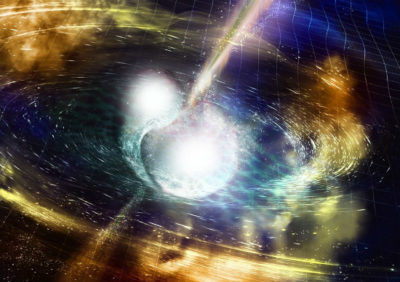3 questions with UMKC faculty about this astronomical hot topic
A conversation with Mark Brodwin, associate professor in the University of Missouri-Kansas City Department of Physics and Astronomy
Scientists recently witnessed the spectacle of colliding neutron stars. What are they?
Brodwin: When a very massive star runs out of fuel to burn, it explodes in a huge supernova leaving behind a neutron star or, if the star is very massive, a black hole. A neutron star is a very compact ball of neutrons with the extreme density of an atomic nucleus. A typical neutron star has a mass twice that of our sun, but a size about that of Overland Park. It’s so dense that a teaspoon would weigh about as much as Mount Everest!
Since stars are often part of binary star systems, at the end of their lives they often become pairs of orbiting neutron stars. Over 100 years ago, Einstein predicted accelerating masses radiate gravitational energy much like accelerating charges emit light. With gravity, the energy is carried away as a rippling wave in the fabric of spacetime itself. As more energy is carried away, the two neutron stars spiral in toward each other and eventually coalesce and merge together. This is among the most energetic events in the universe. Only merging black holes and the Big Bang itself are more energetic. Astronomers have long suspected that it is in these energetic mergers of neutron stars that the bulk of the heavy metals — gold, silver, platinum, etc — are created. The mergers should also put on a dramatic light show, with emission from highly energetic gamma rays and X-rays to optical light and low energy infrared and radio emissions.

Brodwin
Two years ago, a new instrument called the the Laser Interferometer Gravitational-Wave Observatory (LIGO) announced it had made the first ever detection of gravitational waves emitted from merging black holes. This discovery won the 2017 Nobel Prize in physics. In August 2017, LIGO detected gravitational waves from what looked like a merger of neutron stars. At almost exactly the same time, a NASA satellite saw a flash of gamma rays. Astronomers began searching for the source, which was quickly determined to be a relatively nearby galaxy — only 130 million light years away!
Why are colliding neutron stars a huge deal?
Brodwin: Extensive observations from telescopes on Earth and in space were able, for the first time, to experimentally confirm that the brief gamma ray flashes we had long seen are indeed due to merging neutron stars (as had been hypothesized), and merging neutron stars produce most of the heavy metals in the universe, including the rings and watches we wear.
This discovery largely completes our understanding of where and how every element in the universe is made.
What do colliding neutron stars mean for the future of astronomy?
Brodwin: This was the very first example of “multi-messenger” astronomy. For the first time, two different kinds of signals — both gravitational and electromagnetic waves — were detected from the same object. This opens a whole new window on the universe. For the first time in history, we can study the universe using more that just light. We are using the vibrations in spacetime itself.
>Explore the College of Arts and Sciences

